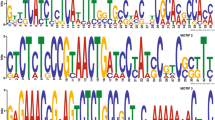Abstract
The fungicidal class I endochitinases (E.C.3.3.1.14, chitinase) are associated with the biochemical defense of plants against potential pathogens. We isolated and sequenced a genomic clone, DAH53, corresponding to a class I basic endochitinase gene in pea, Chil. The predicted amino acid sequence of this chitinase contains a hydrophobic C-terminal domain similar to the vacuole targeting sequences of class I chitinases isolated from other plants. The pea genome contains one gene corresponding to the chitinase DAH53 probe. Chitinase RNA accumulation was observed in pea pods within 2 to 4 h after inoculation with the incompatible fungal strain Fusarium solani f. sp. phaseoli, the compatible strain F. solani f.sp. pisi, or the elicitor chitosan. The RNA accumulation was high in the basal region (lower stem and root) of both fungus challenged and wounded pea seedlings. The sustained high levels of chitinase mRNA expression may contribute to later stages of pea's non-host resistance.
Similar content being viewed by others
References
Boller T: Induction of hydrolases as a defense reaction against pathogens. In: Key JL, Kosuge T (eds) Cellular and Molecular Biology of Plant Stress, pp. 247–262. Alan R. Liss, New York (1985).
Boller T: Hydrolytic enzymes in plant disease resistance. In: Kosuge T, Nester EW (eds) Plant-Microbe Interactions: Molecular and Genetic Perspectives, Vol 2, pp. 385–413. Macmillan, New York (1987).
Broekaert WF, Peumans WJ: Pectic polysaccharides elicit chitinase accumulation in tobacco. Physiol Plant 74: 740–744 (1988).
Broglie KE, Gaynor JJ, Broglie RM: Ethylene-regulated gene expression: Molecular cloning of the genes encoding an endochitinase from Phaseolus vulgaris. Proc Natl Acad Sci USA 83: 6820–6824 (1986).
Chang M-M, Hadwiger LA, Horovitz D: Molecular characterization of a pea β-1,3-glucanase induced by Fusarium solani and chitosan challenge. Plant Mol Biol 20: 609–618 (1992).
Danhash N, Wagemakers CAM, van Kan JAL, de Wit PJGM: Molecular characterization of four chitinase cDNA obtained from Cladosporium fulvum-infected tomato. Plant Mol Biol 22: 1017–1029 (1993).
Fristensky B, Riggleman RC, Wagoner W, Hadwiger LA: Gene expression in susceptible and disease resistant interactions of peas induced with Fusarium solani pathogens and chitosan. Physiol Plant Pathl 27: 15–28 (1985).
Gaynor JJ: Primary structure of an endochitinase mRNA from Solanum tuberosum. Nucl Acid Res 16: 5210 (1988).
Hadwiger LA, Beckman JM: Chitosan as a component of pea-Fusarium solani interactions. Plant Physiol 66: 205–211 (1980).
Hedrick SA, Bell JN, Boller T, Lamb CJ: Chitinase cDNA cloning and mRNA induction by fungal elicitor, wounding, and infection. Plant Physiol 86: 182–186 (1988).
Hooft van Huijsduijnen RAM, Kauffmann S, Brederode FTh, Corenelissen BJC, Legrand M, Fritig B, Bol JF: Homology between chitinases that are induced by TMV infection of tobacco. Plant Mol Biol 9: 411–420 (1987).
van Kan JAL, Joosten MHAJ, Wagemakers CAM: differential accumulation of mRNAs encoding extracellular and intracellular PR proteins in tomato induced by virulent an avirulent races of Cladosporium fulvum. Plant Mol Biol 20: 513–527 (1992).
Kendra DF, Christian D, Hadwiger LA: Chitosan oligomers from Fusarium solani/pea interactions. Chitinase/β-glucanase digestion of sporelings and from fungal wall chitin actively inhibit fungal growth and enhance disease resistance. Physiol Mol Path 35: 215–230 (1989).
Laflamme D, Roxby R: Isolation and nucleotide sequence of cDNA clones encoding potato chitinase genes. Plant Mol Biol 13: 249–250 (1989).
Margis-Pinhero M, Martin C, Didierjean L, Burkard G: Differential expression of bean chitinase genes by virus infection, chemical treatment and UV irradiation. Plant Mol Biol 22: 659–668 (1993).
Mauch F, Hadwiger LA, Boller T: Ethylene: symptom, not signal for the induction of chitinase and β-1,3-glucanase in pea pods by pathogens and elicitors. Plant Physiol 76: 607–611 (1984).
Mauch F, Hadwiger LA, Boller T: Antifungal hydrolases in pea tissue. I. Purification and characterization of two chitinases and two β-1,3-glucanases differentially regulated during development and in response to fungal infection. Plant Physiol 87: 325–333 (1988).
Mauch F, Mauch-Mani B, Boller T: Antifungal hydrolases in pea tissue. Plant Physiol 88: 936–942 (1988).
Meins F, Fritig B, Linthorst HFM, Mikkelsen JD, Neuhaus J-M, Ryals J: Plant chitinase genes. Plant Mol Biol Rep 12: 522–528 (1994).
Neuhaus J-M, Sticher L, Meins FJr. Boller T: A short C-terminal sequence necessary and sufficient for the targeting of chitinases to the plant vacuole. Proc Natl Acad Sci USA 88: 10362–10366 (1991).
Nishizawa Y, Hibi T: Rice chitinase gene: cDNA cloning and stress-induced expression. Plant Sci 76: 211–218 (1991).
Roby KC, Toppan A, Esquerre-Tugaye M: Cell surfaces in plant-microorganism interactions. Plant Physiol 81: 228–231 (1986).
Samac DA, Hironaka CM, Yallaly PE, Shah DM: Isolation and characterization of the genes encoding basic and acidic chitinase in Arabidopsis thaliana. Plant Physiol 93: 907–914 (1990).
Schlumbaum A, Mauch F, Vogeli U, Boller T: Plant chitinases are potent inhibitors of fungal growth. Nature 324: 365–367 (1986).
Shinshi H, Mohnen D, MeinsJr F: Regulation of a plant pathogenesis-related enzyme: Inhibition of chitinase and chitinase mRNA accumulation in cultured tobacco tissues by auxin and cytokinin. Proc Natl Acad Sci USA 84: 89–93 (1987).
Shinshi H, Neuhaus J-M, Ryals J, Meins FJr: Structure of a tobacco endochitinase gene: evidence that different chitinase genes can arise by transposition of sequence encoding a cysteine-rich domain. Plant Mol Biol 14: 357–368 (1990).
Vad K, de Neergaard E, Madriz-Ordenana K, Mikkelsen JD, Collinge DB: Accumulation of defence-related transcripts and cloning of a chitinase mRNA from pea leaves (Pisum sativum L.) inoculated with Ascochyta pisi Lib. Plant Sci 92: 69–79 (1993).
Vogeli-Lange R. Hansen-Gehri A, Boller T, Meins FJr: Induction of the defense-related glucan hydrolases β-1,3-glucanase and chitinase, by tobacco mosaic virus infection of tobacco leaves. Plant Sci 54: 171–176 (1988).
Wagoner W, Loschke DC, Hadwiger LA: Two-dimensional electrophoretic analysis of in vivo and in vitro synthesis of proteins in peas inoculated with compatible and incompatible Fusarium solani. Physiol Plant Path 20: 99–107 (1982).
Author information
Authors and Affiliations
Rights and permissions
About this article
Cite this article
Chang, MM., Horovitz, D., Culley, D. et al. Molecular cloning and characterization of a pea chitinase gene expressed in response to wounding, fungal infection and the elicitor chitosan. Plant Mol Biol 28, 105–111 (1995). https://doi.org/10.1007/BF00042042
Received:
Accepted:
Issue Date:
DOI: https://doi.org/10.1007/BF00042042




